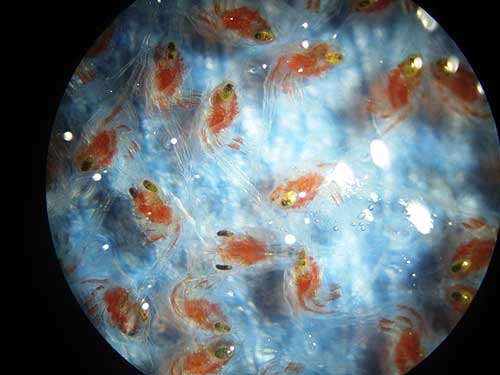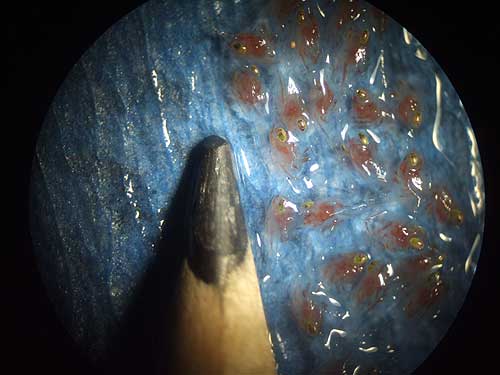 May 31, 2007
"Blue king crab larvae started to hatch around the middle of April," said Celeste Leroux, a University of Alaska Fairbanks graduate student conducting feeding trials with the new crabs. It's been busy around here."  Photograph Courtesy Celeste Leroux, Alaska Sea Grant By mid-May, the hatch had peaked and begun to trail off, said Ben Daly, research biologist at the hatchery. In all, the hatch of 1.75 million blue king crab larvae came about three months after adult red king crabs at the hatchery produced more than two million larvae for the research program. "Blue king crab tend to hatch their eggs later than red king crab, said Leroux. "We also kept the water slightly cooler to delay the hatch until we had room in the hatchery for the larvae." Last winter, egg-bearing blue king crabs were collected from waters around the Pribilof Islands to serve as brood stock for Alaska's first effort to mass-culture wild king crabs. Red king crab brood stock also was collected from waters around Kodiak last summer. The overall effort, called the Alaska King Crab Research, Rehabilitation and Biology Program, or AKCRRAB, is aimed at perfecting mass culturing techniques that might one day be used to rebuild low numbers of red king crabs around Kodiak Island and blue king crabs around the Pribilof Islands.  Photograph Courtesy Celeste Leroux, Alaska Sea Grant.
NOAA Alaska Sea Grant Program runs the AKCRRAB program through a partnership with the Central Bering Sea Fishermen's Association, Aleutian Pribilof Island Community Development Association, and the United Fishermen's Marketing Association. Other partners and supporters include the Kodiak City and Borough, City of St. Paul, NOAA Fisheries, NOAA Aquaculture, the Alutiiq Pride Shellfish Hatchery and Chugach Regional Resources Commission, University of Alaska Fairbanks School of Fisheries and Ocean Sciences, Gulf of Alaska Coastal Communities Coalition, and the Alaska Crab Coalition, among others None of the blue or red king crab larvae hatched at the hatchery will be released into the wild. Instead, the larvae will be used to better understand feeding, habitat, water quality, and other aspects of raising large numbers of crab in a hatchery setting. Later this summer, the program will transplant some of the juvenile crabs into tanks that simulate wild conditions to study such things as habitat preferences for young crab.
Source of News & Photographs:
Publish A Letter on SitNews Read Letters/Opinions
|